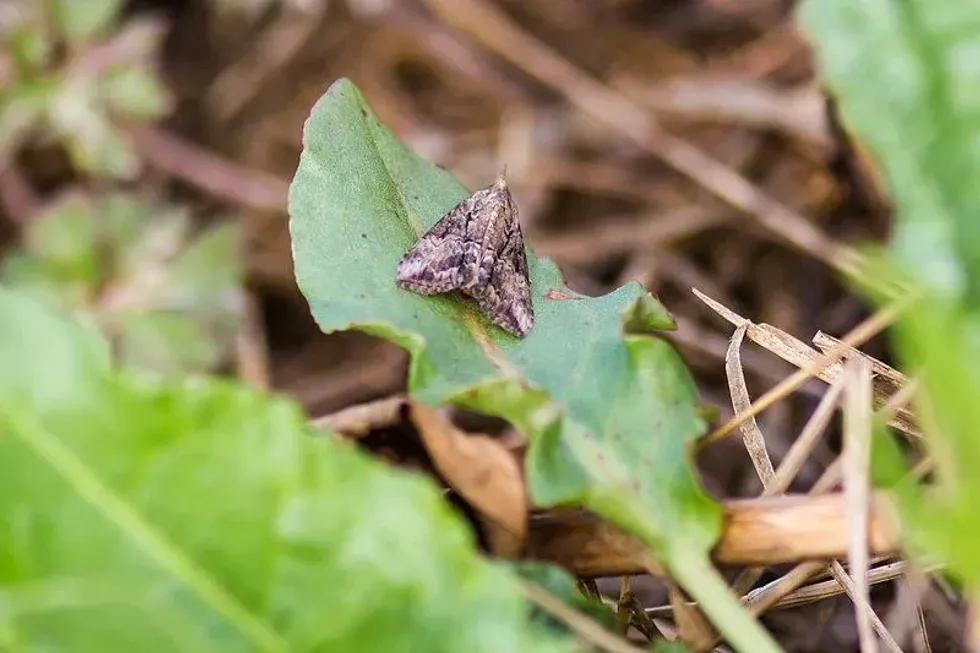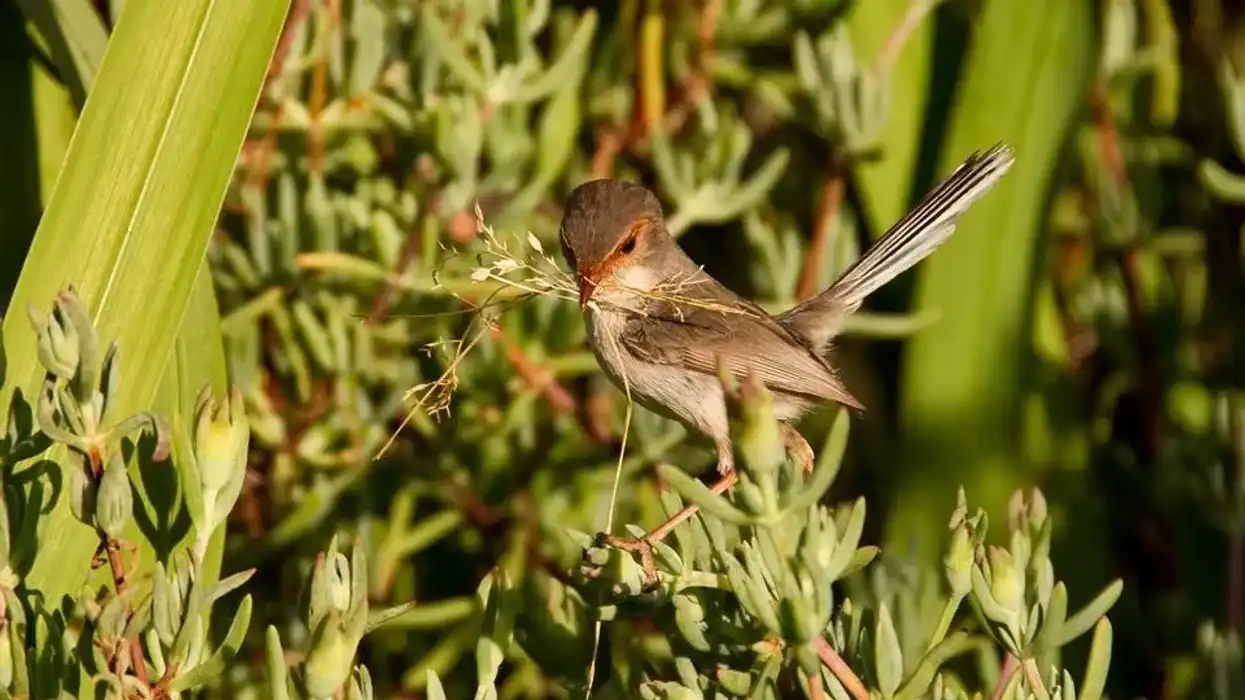The green cloverworm (Hypena Scabra) is a moth of the phylum Arthropoda, order Lepidoptera, and subfamily Noctuoidea. They are also known as black snout moths and are responsible for soybean defoliation which is tough to control.
The larvae are pale yellow to light green in color and have a white stripe running on each side of their bodies.
Adult identification is quite easy. They have four pairs of prolegs in an arrangement that one pair is at the end of the body and the rest three pairs in the middle of the body and an extension of white stripes on both sides.
The green cloverworm is a leaf-feeding insect that can mostly be found in soybean fields from late June to September and has a life cycle of two generations every year.
The countries of the United States and Canada are where you can easily spot these moths. Although they are behind soybean defoliation, they are not considered serious pests in the southern states.
Have an interest in insects and want to know about more of them? Here you can know some amazing facts about the wheel bug and stick bug!
Green Cloverworm Interesting Facts
What type of animal is a green cloverworm?
The green cloverworm (Hypena scabra) is a type of insect which prefers to live in habitats like small fields, agricultural land, gardens, and most soybean fields. This moth is commonly seen in North America. They are also known as black snout moths and are brown in color.
What class of animal does a green cloverworm belong to?
This insect belongs to the kingdom Animalia, the class Insecta, and the subfamily Noctuoidea. Green cloverworm larvae identification shows that they are pale yellow to green in color, unlike the adult green cloverworm caterpillar. The green cloverworm scientific name is Hypena scabra.
How many green cloverworms are there in the world?
The exact population of this brown insect is not known, but they are in abundance in the temperate Northern Hemisphere and can be seen easily. They are increasing continuously in fields and causing damage to the growth of soybeans.
Where does a green cloverworm live?
This brown green cloverworm moth prefers to live among plants so that it can eat leaves easily. They live in fields, woodlands, and gardens. Due to this, the growth of various fruits is damaged as green cloverworm moth larvae feed on leaves and tend to eat the buds of fruits.
What is a green cloverworm's habitat?
The green cloverworm moth's preferred habitats are regions of any plants or small shrubs. They live in this habitat because both larvae and adult larvae need fresh leaves to survive.
They most commonly host and live on soybeans which causes its defoliation. This needs to be controlled. Green cloverworm eggs can be seen on any flowerinf plant or underneath a leaf.
Who do green cloverworms live with?
They can only be seen living on the leaf of the host plant. Sometimes, they live in small groups of three to four maybe on a particular leaf, but most of the time, they are seen living alone.
How long does a green cloverworm live?
The green cloverworm life cycle has two stages. The first stage if when larvae become a caterpillar, and the second is when the caterpillar becomes a moth. The total time larvae take to become a caterpillar is roughly around 14-26 days and time taken for a caterpillar to become a moth is around 20-30 days.
How do they reproduce?
Soybean green cloverworm moths prefer the warm temperatures of spring to mate. Females lay eggs on the underside of the plant and the eggs take four to five days to hatch.
The young larvae almost take a month to develop completely as they develop in six stages. Older larvae are buried into the soil to pupate for an approximate duration of 7-10 days.
What is their conservation status?
According to the International Union for Conservation of Nature (IUCN), the soybean green cloverworm is under the category of Least Concerned species. These moths are very common in North America and are often confused with loopers.
Green Cloverworm Fun Facts
What do green cloverworms look like?
The green cloverworm chrysalis is light green to pale yellow in color at the young larvae and old larvae stages. They have four pairs of prolegs on their body with two white stripes having an extension to the end of their body.
One distinct characteristic of these insects is that they tend to jump when they are disturbed. The adult green cloverworm has a triangular brown shape when they are at rest.
Females have charcoal with silver and dark brown patches on their bodies which makes their identification very easy, and the males have charcoal wings. The male possesses larger eyes and body than females.
How cute are they?
The caterpillar stage, when they are light green in color and the adult stage when they are dark brown in color, can be both considered cute. However, due to their wavy body movements and small thread-like body, they also have a gross look too!
How do they communicate?
There is not much information about the ways they communicate. Like other caterpillars, these leaf-feeding insects use their body movements to communicate.
How big is a green cloverworm?
The green cloverworm or black snout moth belongs to the Insecta class and is 1 – 1.4 in (25 - 35 mm) long. The Luna moth of the same class Insecta is two times the size of these tubeworms.
How fast can a green cloverworm move?
These insects crawl very slow and because of this, large birds catch them easily. They have a speed of just 1 mph (1.6 kph).
How much does a green cloverworm weigh?
The exact weight of these clover worms is unknown but the average weight of a caterpillar is 0.006 lb (0.1 oz).
What are the male and female names of the species?
There are no specific names given to the male and female of this species.
What would you call a baby green cloverworm?
The baby of a green cloverworm is called a larva.
What do they eat?
They are herbivore insects and feed on a leaf of a particular host plant. They have various preferred hosts like soybean, strawberries, cowpea, clover, alfalfa, and beans.
Are they dangerous?
They are not dangerous to human beings but are responsible for the defoliation of soybean plants as the green cloverworm bite eats all the leaf and only the skeleton is left at the end. Green cloverworm damage is very severe and needs proper management and control.
Would they make a good pet?
These creatures are small insects and can be harmful to babies as they can crawl inside their bodies through their ears or noses.
Did you know...
Though the damage caused by older larvae to soybeans is very high, still many think that with proper management, these larvae can become useful. Larvae attract predators and can consume other more serious pests.
How to get rid of green cloverworms?
There are places that are specialized for green cloverworm moth infestation as they are dangerous to both plants and humans. Green cloverworm damage is mostly faced by soybean plants.
There are many chemicals like Ambush 2EC, Asana XL, Lorsban 4E, Pounce 3.2EC, Penncap-M, Sevin XLR Plus, and Warrior T, which you can use to get rid of them. One thing to keep in mind is that you should never spray these chemicals on a windy day as the chemical will not stick to the plant.
What is the difference between the soybean looper vs. green cloverworm larvae?
The soybean ;ooper (Chrysodeixis includens) has a light green body and also feeds on soybeans. They have a wavy body movement and because of this, they got their name loopers.
Unlike the green cloverworm, loopers are migratory and belong to a different family and genus Noctuidae and Chrysodeixis respectively. Their management and control are much harder and they have only two pairs of prolegs. Their identification can be tough because they look very same.
Here at Kidadl, we have carefully created lots of interesting family-friendly animal facts for everyone to discover! For more relatable content, check out these caterpillar facts and the puss moth facts for kids.
You can even occupy yourself at home by drawing one of our free printable green clover worm coloring pages.









